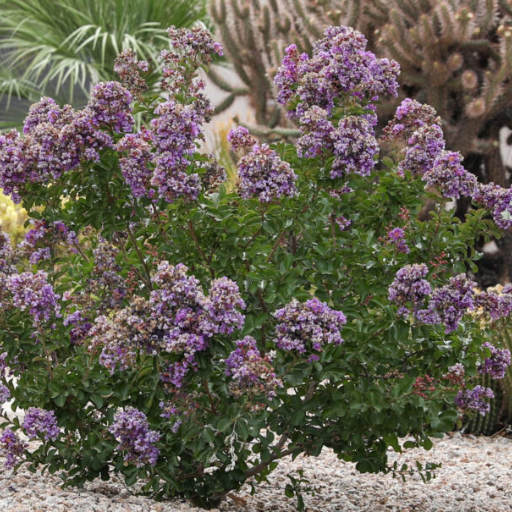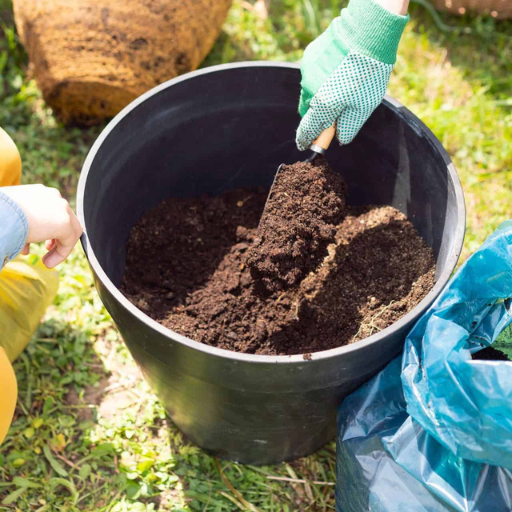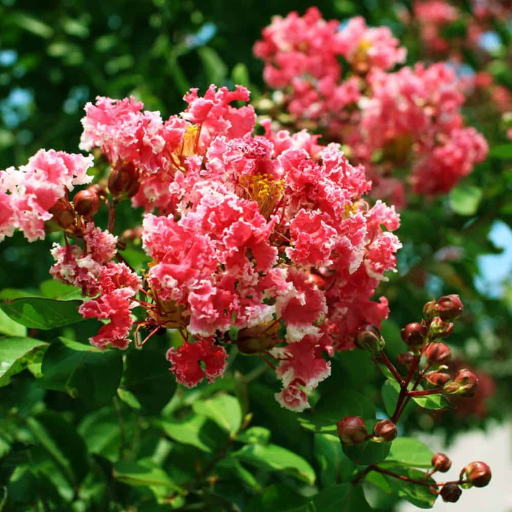Crape myrtles are beloved for their stunning, vibrant blooms and their ability to thrive in a variety of climates. To achieve the healthiest and most magnificent flowers, proper care and nourishment are essential. This blog will guide you through the process of selecting the best organic fertilizers to ensure your crape myrtles remain robust and blooming throughout the season. We will cover the benefits of organic fertilizers, the specific nutrients crape myrtles need, and the best practices for application. Whether you’re a seasoned gardener or a beginner looking to enhance your crape myrtle care routine, this guide will provide you with valuable insights and practical tips to achieve lush, healthy blooms.
Why is it Important to Fertilize Crape Myrtles?

Benefits of using organic manure in growing crape myrtle flowers
Organic fertilizers are very advantageous to the growth of crape myrtles and they help them to flourish naturally in their environment. Firstly, organic manure improves soil texture through increasing its percentage of organic matter thus making it well aerated and water retentive. This allows for better root growth and improved nutrient uptake. Furthermore, when we apply organic fertilizer, nutrients are released slowly over time; hence providing a steady supply of nutrients to plants while reducing the risk of nutrient burn. They also promote beneficial microbial activity, which aids in breaking down nutrients into accessible forms for the plant. By applying organic fertilizers you will also reduce chances of soil poisoning due to chemical buildup that makes gardens non-sustaining. In conclusion, organic fertilizers create stronger healthier myrtles with bright long-lasting flowers.
How to know when your Crape Myrtles need Fertilizer
To find out if your crape myrtles require fertilizer here some signs you can look out for. One apparent symptom that your crape myrtles might exhibit is poor blooming where there would be few flowers or smaller than average blooms respectively. Additionally, yellowing leaves especially those falling off prematurely means insufficient amounts of nutrients available in the soil. Slow growthes and weak skinny branches might point out that lack sufficient nutrients in your crepes mirtous as well. Such conditions may affect nutrient absorption for example compacted soil with less quantities of compost material found on it might result in this condition therefore watch this kind of condition closely too. If these signals are detected early enough then one should make sure he applies manure at an right time so as to maintain a healthy and vibrant garden space full of life and splendoring colors which happen when bloomers remain strong throughout their life span.
What Kind of Fertilizer is Best for Crape Myrtles?
The Understanding Fertilizer Labels: 10-10-10 and Other Ratios
Fertilizer labels are vital in understanding the nutrient content and suitability for crape myrtles. The numbers that you see, such as 10-10-10, indicate the weight percentage of Nitrogen (N), Phosphorus (P) and Potassium (K) respectively. This type of ratio is classified as a well balanced fertilizer which provides equal amounts of these vital nutrients to support the overall health of the plant including foliage growth, root development, and flowering.
Nitrogen helps to produce lush green foliage, phosphorous promotes root and flower development while potassium strengthens overall plant strength in terms of disease resistance and environmental stresses. In this case, average or slightly higher-phosphorous fertilizers may be beneficial for crape myrtles during their blooming phase. Other ratios like 5-10-5 or 12-4-8 show variations in nutrient levels targeted at meeting specific requirements in plants either to promote flowering or enhance robust growth.
When choosing a fertilizer, it is important to ensure that the nutrient ratio matches with your crape myrtles’ needs and also take into account soil test results so that any deficiencies can be supplemented effectively. This will make sure your blooms are vibrant as well as promote healthy growth of your crape myrtles.
Top Organic Fertilizers for Crape Myrtles
Cattle Manure:
- Composted cattle manure is an ideal organic fertilizer because it contains a balance amount of crucial nutrients necessary for healthy soil texture. It adds vital elements plus friendly microorganisms into the soil resulting in vigorous shoots development with stronger roots. Apply by working them into the ground around where your bushes stand or just topdress with mulch.
Bone Meal:
- Bone meal is rich in phosphorus and calcium providing slow release food for strong roots systems and great blooming on demand. It’s a type of organic nutrient that slowly feeds the crop so it is useful during the blooming stage of crape myrtles. Sprinkle it around the base of your plant and lightly turn it into the soil in order to use bone meal.
Fish Emulsion:
- Fish emulsion is a fast acting source of nutrients, particularly nitrogen which enhances lush foliage growth. Additionally, this fertilizer contains several microelements that facilitate general health of plants. Normally, it is diluted with water and can be sprayed as foliar or used in direct contact with the ground making it useful as an organic option for crape myrtles.
By using these organic fertilizers you can greatly enhance their health and flower production thus turning your garden into a vibrant showcase.
When and How Often to Fertilize Your Crape Myrtle
Crape myrtles benefit from being regularly fertilized to ensure optimal growth and blooming. Generally, crape myrtles should be fed early in spring when new leaves are sprouting. This timing ensures that they get all the necessary nutrients for healthy vigorous growth at onset of growing season. A second application can be made in late spring or early summer but beyond this one there is no need unless there are signs of nutritional deficiencies.
For the first treatment, apply evenly around base of plant composted cattle manure, bone meal or fish emulsion and lightly mix it into soil surface. Before applying any kind of fertilizer whether organic or synthetic fertilizers, wet soil becomes essential so as not to cause root burn since roots continue absorbing nutrients.
By following this schedule and adjusting accordingly for your specific plants’ needs you can guarantee flourishing crape myrtles throughout the growing season.
How Do You Care for Crape Myrtles Throughout the Year?

Proper Irrigation Methods for Crape Myrtles
Right watering is vital for the life and brightness of crape myrtle. During the first year, it is important to water your crape myrtle deeply on a regular basis to establish healthy roots. In practice, this means providing about an inch of water every week either by rainfall or manual watering. Just make sure that you are watering at the base of the plant in order not to wet the leaves because this may result in fungal diseases.
Once established, crape myrtles can withstand prolonged droughts quite easily. Subsequently, they will mostly survive on rain alone with a need for extra irrigation during extended dry spells only. When supplemental irrigation is necessary, instead of shallow watering; it’s better to water deeply and infrequently. Such deep watering makes roots penetrate deeper beneath soil surface and hence more resistant to drought conditions.
To improve moisture retention in the soil apply mulch around the plant’s base. This will help retain soil moisture, moderate soil temperature and minimize weed competition. Nonetheless, ensure that mulch doesn’t touch the trunk so as not cause decay or encourage pests’ invasion.
These techniques can be followed to keep good blossoms on your crape myrtles throughout the year.
Pruning Tips: When and How to Prune Your Crape Myrtle
Crape myrtles need pruning to maintain their shape as well as promote healthiness and blooming potential but it has to be done at right times using proper methods. The most suitable period for pruning your crape myrtle would be late winter or early spring just before new growth starts taking place. Such timing enables one remove old seed pods together with any unhealthy or crossed branches minus interrupting forthcoming bloom cycles.
When you start pruning remove suckers (small shoots growing from its base), dead or diseased branches plus crossing ones. This allows sunlight penetration through canopy with improved air circulation within it. You should not cut back branches to stubs or top which is referred to as crape murder, but instead focus on thinning out the canopy by selectively removing entire branches. This will provide a more natural and appealing shape at the same time promoting more flowers.
In matured crape myrtles, structure is maintained through removal of lower branches in order to raise canopy like tree form. Always use clean and sharp pruning tools making smooth cuts while avoiding over-pruning that may result in weak growth or reduced blooms. Following these pruning guidelines will help your crape myrtle stay healthy, pleasing, and abundantly flowered.
Common Pests and Diseases
Crape myrtles are quite resilient plants; however they may still suffer from some common pests and diseases that can impact their healthiness as well as flowering potential. One of the major pests to look out for is the crape myrtle aphid that secretes honeydew thus causing sooty mold. In order to control aphids you may introduce ladybugs which feed on them or apply insecticidal soap among others. Also, scale insects are other common pests which can be eliminated through horticultural oil or systemic insecticides.
Powdery mildew is a common problem in terms of diseases, particularly in areas that have high humidity. The fungal infection appears like white powder on leaves which can be treated by ensuring adequate air circulation and occasionally applying fungicides. Premature leaf drop occurs because of cercospora leaf spot, a different type of fungal disease. For the control of this disease, remove and dispose of infected leaves then apply fungicides.
To keep your plants healthy and strong, it’s necessary to monitor them constantly for pests and diseases and act immediately when you notice any problem with your crape myrtles.
What are the Best Practices for Plant and Soil Preparation?

Preparing the Soil for Planting Crape Myrtles
Crep myrtles need to be properly prepared before planting. Choose a site that will receive full sun, since crepe myrtles do well in bright conditions. The soil should drain well; if necessary, add organic matter like compost or well-rotted manure to improve soil structure and fertility.
Prior to planting, conduct a soil test to determine pH levels ranging from slightly acidic to neutral (5.5-7.0). If the soil is too alkaline, it can be corrected by means of sulfur amendments which lower the pH. Dig a hole twice as wide and of equal depth with the root ball of the plant so that there will be adequate room for root expansion. Loosen up the ground at the bottom of the hole while adding some organic matter with an intention of helping roots get established quickly and healthily.
The above-discussed practice allows you to provide an excellent growing condition for your crape myrtle plants hence promoting their vigorous growth and prolific flowering.
Soil Testing: Why Is It So Critical?
When it comes to soil testing, it is important because it gives detailed information on nutrient content, ph value and condition of your soil at large. This knowledge also helps you modify your soils amendments in order to satisfy your particular crape myrtle requirements entailing balanced nutrients vital for healthy vegetation increase. With regards to deficiency or toxicity levels in minerals, these tests enable farmers adjust before planting begins hence avoiding related problems later on such as stunted growths or even deaths among others. Futhermore they assist in determining amount and type e.g fertilizer ,soil conditioner which are needed thus improving further roots growth as well as flowering rates .Repeatedly checking one’s soils prevents excessive manuring thereby minimizing environmental pollution besides wastage’s involved when unnecessary inputs are employed.
Mulching Techniques That Work Best For Crepe Myrtle Plants
Mulching is crucial for water retention, suppressing weed growth and moderating soil temperature around crepe myrtle plants. First remove any weed or grass that may be on the spot where mulch will be used. Spread a 2 to 4-inch layer of organic mulch such as wood chips, pine bark or shredded leaves around the base of your plant. The mulch should reach the drip line but keep a few inches away from the trunk to prevent it from rotting and being attacked by pests. In this case besides soil structure and fertility improvement through decomposition of this dressing, one’s crepe myrtle also gets other general health benefits which contribute towards its overall development. It may need to top up its thickness annually in order to remain effective thus retaining moisture that would have otherwise been lost through evaporation during hot weather conditions for instance dry spells in summer periods.
How to Ensure Optimal Growth and Bloom of Crape Myrtles?

Proper Sunlight Exposure
To ensure proper sunshine conditions for crape myrtles, I make sure that they receive plenty of direct sunlight. The best place for crape myrtles to thrive is in full sun, which means that they require at least six hours of direct sunlight every day. Placing them in shady spots where they get overshadowed by larger trees or houses is also a bad idea. By giving abundant light to my crape myrtles, they become more colorful and grow healthier. Furthermore, good exposure to the sun reduces susceptibility to mildew and other fungal diseases that thrive well in damp and shaded conditions.
Guidelines for Encouraging Healthy Bloom Cycles
In order to encourage healthy bloom cycles in my crape myrtles, I am keen on proper pruning and adequate watering. During late winter or early spring when the plants are dormant, I trim them thereby getting rid of any dead or weak branches which stimulate vigorous new growth. Moreover, I water the crape myrtles deeply but not frequently so that the soil stays moist all through but never waterlogged. Additionally, using a balanced slow-release fertilizer during early spring also provides the required nutrients for profuse blooming. Lastly, positioning these crops appropriately ensures that there is enough air flow around them such that diseases can be minimized as well as supporting healthy flower blooms.
The Role of Regular Fertilization in Shrub Growth Enhancement
For example, regular feeding enhances bush growth on these shrubs such as my crape Myrtle bushes (Botanical name). Applying a balanced slow-release fertilizer during early spring helps me have a continuous supply of nutrients necessary throughout the growing season for growth of these plants .This practice leads to strong growths accompanied by thick leaves and many flowers. Over application of fertilizers is dangerous thus I follow guidelines given about various types of fertilizers given.. After applying fertilizers I clearly notice improved plant vigor and resistance to pests and diseases. Survive fertilization, accompanied by appropriate watering and sufficient sunlight, enables my crape myrtles to flourish all the time they are still alive.
Frequently Asked Questions (FAQs)

Q: Can crape myrtles grow in a wide range of soils?
A: Yes, they can grow on any kind of soil provided it is not waterlogged. Nonetheless, these plants do best in slightly acidic to neutral soil conditions.
Q: What are some tips for growing crape myrtles?
A: Basic guidance on how to grow crape myrtles include planting in full sun, ensuring good drainage and adding mulch to retain moisture. In addition, regular applications of fertilizers during the early spring and pruning before the end of winter may enhance healthy growth and blooms.
Q: How should I prepare the planting hole for a new crape myrtle?
A: For planting the new crape myrtle, dig a hole twice as wide as the root ball but no deeper than its height so that roots establish quickly. Additionally, compost added into this hole would provide vital nutrients required by the young tree.
Q: What type of fertilizer is ideal for crape myrtles?
A: An example is well-balanced 12-4-8 or 16-4-8 ratios containing nitrogen (N), phosphorous (P) and potassium (K) respectively which are the main essential plant nutrients facilitating greenness and flowering thus leading to healthy plants.
Q: What is the time to prune crape myrtles for the best results?
A: It is preferable to prune them at this time since old flowers are often removed from weak or dead branches; hence shaping them up before summer adds life to them during spring season.
Q: How do I maintain the tree shape of crape myrtles?
A: The maintenance should be done with regular pruning so that any low-growing branches and suckers growing from their base cut away. The goal of pruning should be to create an open airy structure that will encourage healthy growth as well as highlight its peeling bark, summer flowers.






